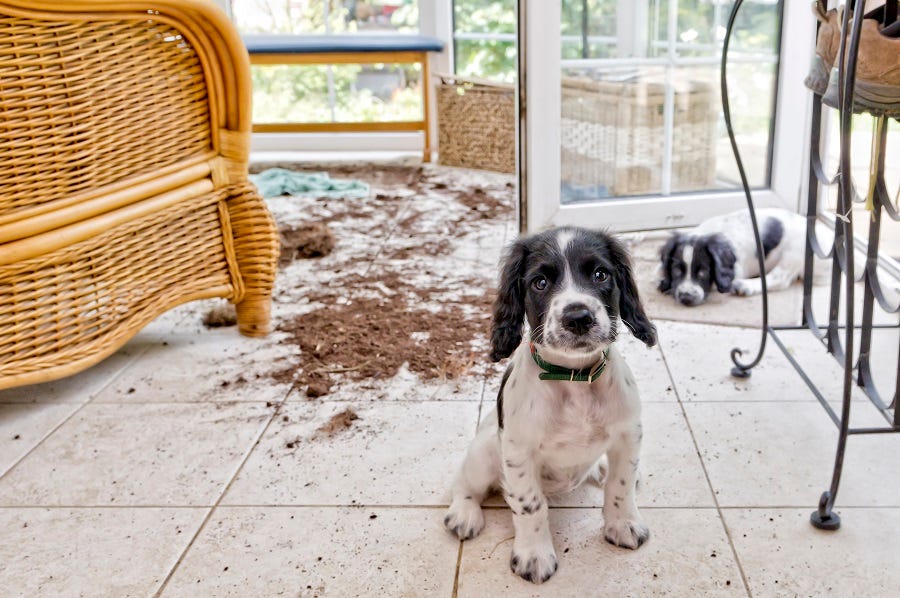Any pet parent will tell you that a bored puppy is often a destructive puppy. Without their precious playtime, nothing is safe – from the garden, to furniture and even your favourite pair of shoes.
These furballs have a seemingly endless supply of energy, but with the right play and exercise, you’ll be able to train your puppy in no time! We’ll take you through everything you need to know about playing and exercising with your fur friend.
Why is play so important?
Just like us, puppies need exercise to stay healthy and strong. However, exercise and play goes beyond simply benefiting their physical health.
Play is the perfect mental stimulation for dogs and can come in a range of ways, from puzzles to play wrestling, or a good old game of fetch. Through play, puppies can burn off a lot of energy, helping them act well-behaved and calm during other times of the day.
Play is almost essential for your pup's physical development. Through play with their owners or other dogs, puppies run, jump and wrestle, which all helps to develop muscles and strength. You might find that even when your puppy’s playing solo, they are still developing a lot of strength and muscle!
Plus, play is one of the most important aspects of bonding with your new furry friend. Dogs that play games with their owners develop a stronger bond with them, and grow up more sociable.
How to play with a puppy
Now that you know the importance of playing with your puppy, you might find yourself asking how? The same way children often have a favourite playtime activity, you'll find your puppy has games and activities they prefer to others. Test out a variety of toys so you can work out exactly what your fur baby loves. You can experiment with a puzzle or classic puppy chew toys, or try hiding toys and treats to make your own doggy scavenger hunt.
Once they work out their favourite toy, play should happen pretty naturally. However, if you’re still stuck for some ideas, here are some of our top picks of games to play with puppy:
-
Fetch: There's a reason this game is a favourite amongst our fur friends. It's a great way to teach your pup basic commands, including to come when called. Make sure to get your puppy to sit, then throw the toy. Tell them to drop before you offer them plenty of praise when they come back.
-
Tug-of-War: Another favourite, this game can be a great way to help train your pup to drop. Hold onto their favourite toy and offer it to them until they grab on. Then tug back and forth gently (we don't want any hurt mouths or broken teeth!).
-
Create an agility course: Agility games are a great way to get your puppy moving and burning off calories and energy, while increasing their coordination and confidence. Agility courses make for excellent puppy training games. Create an obstacle course in your backyard full of chairs, mini cones or even tunnels. As your pup runs the course, reward them for every obstacle they conquer.
-
KONG and food dispensing toys: What better way to play with your pup than by combining playtime with food? You can stuff food dispensing toys or KONG toys with treats that encourage them to use some of their natural scavenging instincts to get to the food.
While toys and games are a great way to get your pup moving, sometimes you just can't beat a walk! Head out to your local park or try a new walking track packed with new scents for your puppy to investigate.
How much exercise does a puppy need?
While puppy games are a great way to keep your pup moving, you'll want to make sure you take them out for daily walks, too! Young puppies may not need as much exercise as adult dogs, but they'll still want to explore the wider world around them.
The best way to do this is to take them on walks (after they’ve been vaccinated!). As a general rule of thumb, dedicate 5 minutes of exercise per month of age, twice a day. Between 6-18 months, 20-30 minutes of daily walking time is more than enough. Make sure you keep walks relatively short, building up the distance over time. At first it might be a challenge, but teaching your puppy to walk on a leash can be done with plenty of patience.
If your pup has spent all their energy enjoying a long play session with plenty of running around, you might want to keep their walk short or skip it for a day.
Signs over-exercising puppy
Puppies might look like they have endless energy, but it's very easy to over-exercise them. It's essential to know your puppy's exercise limits. Remember that moderation is key! Here are a few things to look out for when exercising your pup:
- Exhaustion, including taking a long time to recover from play.
- Excessive panting and extreme thirst.
- Lagging in their movements.
- Reluctance to continue exercising.
- Sore muscles and stiffness.
- Lack of focus.
- Vomiting and retching.
- Signs of heat exhaustion, like gasping, heavy panting or excessive drooling.
Behaviours to look out for during play
Behaviours that are all fun
The easiest way to know if your puppy is enjoying their playtime is by reading their body language. If your puppy's tail is wagging and they look relaxed, then the chances are they're having a great time!
- Dropping into a low bow: If your puppy puts their front legs on the ground with their back end in the air, then they’re ready to play!
- Grinning: You might find your puppy looking like they're smiling as they play. Just don’t mistake this for baring teeth.
- Exaggerated barking and growling: A puppy growling when playing might be enough to turn you off, but in reality puppies will often ‘play growl’. This often sounds playful and is no cause for alarm!
- Bouncing: Often when playing with other dogs, you might find your puppy bounces around. This is all play!
Behaviours that are crossing the line
- Stiff body language: you might see the hair on their upper back rise and their tail stop wagging. Another great indicator is to look at their ears. Pinned back, flat ears are another sign that your puppy is scared or getting frustrated.
- Closed mouth growls: This low growl is often a good indication that your puppy isn’t happy.
Snapping: Snapping and biting is one of the key signs your pup isn’t having fun. - Quick movements: If their movements are quick, like lunging without the playful bounce, then your puppy is uncomfortable.
- Acts of territorial behaviour: Puppies can easily become territorial over a place, food, toy or person. If you notice your puppy becoming territorial and aggressive, it’s best to separate them or stop play before their aggressive behaviours begin.
Through play, your furry friend will learn important lessons that they’ll carry through their entire lives. As a pet parent, making sure they’re confident, social and friendly are all valuable skills that will set them up for success. Most importantly, keep in mind that play should be fun!
Puppy Play FAQ:
Help! My puppy is aggressive when playing
Remember that responding to aggression with aggression can often make things worse. Instead, always have a toy on hand that your puppy can focus on. If your pup is going for your feet, redirect him with a toy.
Another great tip is to simply stop playing. You can interrupt bad behaviour with a spray of a water bottle, a clap or a loud noise that will startle the puppy into stopping the behaviour.
Instead of punishing, reward your puppy when they do something right.
Why does my puppy bark at me when playing?
Barking during play is totally normal! Think of it as trash-talking your opponent during a game of Monopoly. Barking is generally a good sign that they’re having fun and are excited to play. Keep an ear on the tone – anything too low can be a warning sign that they need a little room.
Can puppies have bones to chew on?
At a young age, it’s best to avoid bones. Your puppy's teeth won’t be fully developed yet, so hard bones in particular can cause damage. Once your pup has a full set of adult teeth, then you can think about giving them a bone safely.




